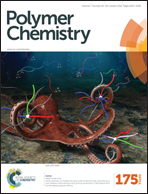Group interval-controlled polymers: an example of epoxy functional polymers via step-growth thiol–yne polymerization†
Abstract
We have coined a new term, group interval-controlled polymers (GICPs), to describe the unique structure of macromolecules with a tunable functional group interval. The precise control of a polymer main chain structure itself is still a big challenge, let alone the purposeful control of group interval simultaneously. Here, we successfully synthesized a series of epoxy GICPs via one-step UV-triggered thiol–yne polymerization of commercial glycidyl propargyl ether and dithiols at 0 °C. Subsequently, α,ω-thiols of each epoxy GICP were capped by two allyl glycidyl ethers via a thiol–ene click reaction, affording a stable product. Their unique group interval-controlled chemical structures were confirmed by a combination of nuclear magnetic resonance (NMR), gel permeation chromatography (GPC) and pyrene-fluorescent probe tests. Moreover, the epoxy groups within the GICPs were highly reactive and could be further functionalized and turned into a diverse range of customized groups such as azide, tertiary amino, thioester, and hydroxyl, etc. Therefore, a series of GICPs with designed functional groups are readily achieved on a large scale. Our work presents a reliable synthetic methodology for GICPs, paving a new way for the precise structure control of artificial macromolecules.


 Please wait while we load your content...
Please wait while we load your content...